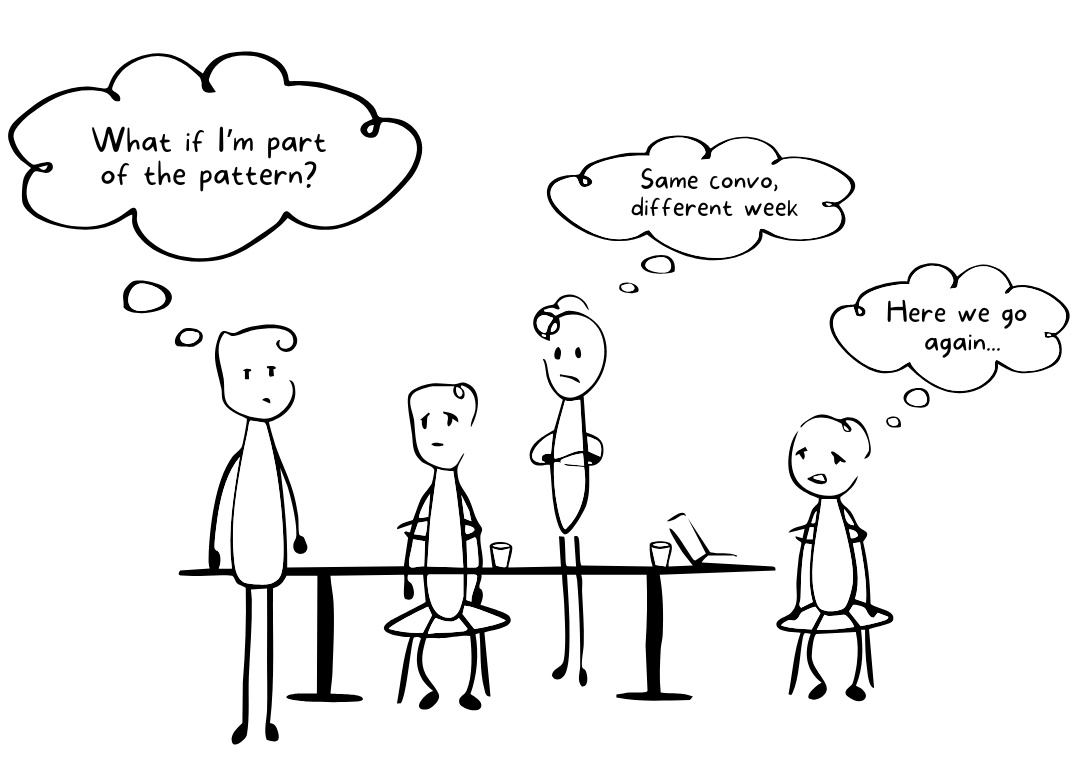When Every Meeting Feels the Same: Leadership Strategies to Break the Pattern | Mindshift Moments

The Moment:
It’s almost time for your weekly director’s meeting and you catch yourself thinking, “I know exactly how that meeting is going to go.” It’s the same script, same cast, same ending. Everyone plays their part, the discussion circles back on itself, and nothing really changes. You walk in already anticipating your frustration.
The Mindshift:
What if your ability to predict the outcome of the meeting isn’t a sign of your insight, but proof that you’ve become part of the pattern? When a group dynamic is stuck, every person is contributing to the script, whether they realize it or not. The truth is, the only way to break the cycle is for something to get different - and the only person you can change is you.
When meetings feel like reruns, it’s easy to check out or get cynical – and there’s a staggering cost to that, which includes your own engagement and the ability for your team to reach its goals. But what if you experimented in your next meeting by changing your lines in the script? Your tone, your energy, and your questions have the power to rewrite the plot. When you step out of the predictable, you create space for everyone else to do the same.
The Strategies:
Try one of these and see if you can disrupt the pattern.
1. Ask the Unexpected:
Challenge the assumptions that keep meetings predictable by bringing fresh, open-ended questions to the table. Here are a few to try:
- What would this look like if we had no constraints?
- What’s a solution we’d try if we were 10 times more bold?
- What would success look like if we could start over from scratch?
- What’s the one thing we’re not saying out loud here?
- What if we took the next five minutes to brainstorm:
- … the wildest solutions we can think of, no matter how impractical?
- … what our customers might be thinking about this?
- … how our front-line staff might feel about this?
These questions disrupt autopilot conversations and invite creativity, honesty, and new perspectives into the room.
2. Bring in A New Perspective:
When the same voices dominate, the same patterns persist. Suggest bringing in someone who isn’t part of the usual group—a colleague from another department, a frontline team member, or even a customer. A fresh perspective can reveal blind spots, challenge assumptions, and shift the energy of the conversation.
3. Name the Pattern:
If you’re noticing a loop, chances are others are too. While it’s tempting to avoid naming it—especially among peers or in front of your boss—calling out the pattern might be the shake-up the group needs. Try something like:
- I feel like we’re circling the same conversation—what’s keeping us from moving forward?
- It seems like we’re all frustrated with this process. What’s one bold step we could take to shift things?
- It feels like we’ve had this meeting before. What’s the smallest change we could make today to get a different result?
Naming the pattern doesn’t have to feel like confrontation—it can be an invitation to explore a better way forward.
4. Flip Your Perspective:
Before the meeting, imagine yourself in someone else’s role—especially someone whose behavior you find frustrating or predictable. What might they be experiencing that’s keeping them in their pattern? In the meeting, approach them with curiosity by saying:
- I’d love to understand your perspective—what do you think is really behind this challenge?
- I’m noticing that this is really important to you—can you help me understand how you are thinking about this?
This strategy creates a disarming moment and shifts the tone from resistance to connection. It’s not about agreeing with them; it’s about breaking the unspoken battle of assumptions and inviting them to step out of their script.
If you find yourself checking out during your next meeting, remember that staying silent means choosing to keep playing your part in the same cycle. And the cost is frustration, disengagement, and a team that feels stuck. Over time, these patterns erode trust, kill momentum, and make real progress impossible. By disrupting the script, you don’t just change the meeting—you change the possibility of what the team can achieve.
